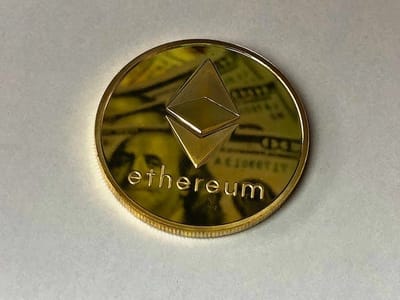blockchain Cyber-Flora and Fauna
New Vancouver



Cryptocurrencies (en digital och virtuell valuta) som Bitcoin och Ethereum drivs av en teknologi kallad Blockchain. Målet med Blockchain är att tillåta digital information till att bli fördelat decentraliserat. Vilket möjliggör att överföra värde online utan behov av 'middlemen' som en bank eller kreditkortföretag; Cyberpunk Future!
CityDao bygger framtidens stad med hjälp av Ethereum Blockchain. En crypto-stad som påbörjas genom att kollektivt köpa land i Wyoming - på ett digitalt vis. Blockchain Crypto City of the Future. Ett experiment i decentraliserad landägande och som ska skänka medborgare rättigheten till ett stycke land. Framtidens stad! Ett fint projekt i form av att skapa helt och hållet nya städer från 'scratch. En stor möjlighet då Blockchain teknologi kommer förändra förvaltningen av smarta städer; riktiga metrpolis. Cyberpunk Future! Allt för att förbättra livet hos invånare. Dubai vill bli den första en Blockchain-driven regering i världen - men ska sägas; Blockchain teknologi i samklang med 'Smart Cities' är fortfarande i de tidiga faserna av utveckling - men som formar morgonstadens städer. Artificiell Intelligens kommer också spela en nyckelroll med smarta applikationer i form av Blockchain till en 'Smart City'. Cyperpunk Future!
Blockchain spelar också en viktig roll i det snabbt utvecklande Metaverse - den virtuella världen i form av 'augmented' och virtuell verklighet för att frambringa en värld av social 'connection' - där användare av Blockchain kan påverka digitala objekt i Metaverse och där 'cryptocurrency' passar perfekt då den är decentraliserad; att kunna ge stabilitet till den omfattande Metaverse-miljön. Cyberpunk Metaverse!
"I love this stuff - bitcoin, ethereum, blockchain technology - and what the CYBERPUNK-Future holds"- Abigail Johnson
"You can't stop things like Bitcoin. It will be everywhere, and the world will have to readjust. World governments will have to readjust" - John McAfee
"Bitcoin is the most important invention in the history of the world since the Internet."— Roger Ver
--
Cyber-Flora and Fauna:
In the neon-bathed streets of the future, where towering skyscrapers and digital billboards paint the skyline, the natural world has not simply receded into the shadows of humanity's technological ambitions. Instead, it has evolved, merging with the cybernetic and synthetic to create a new ecosystem: cyber-flora and fauna. This fusion of the organic and the engineered reflects nature's resilience and adaptability, offering a fascinating glimpse into a world where technology and biology intertwine to survive in the urban sprawls of the cyberpunk era. Imagine walking through the bustling streets of a cyberpunk city, where amidst the concrete and steel, you encounter glowing, bioluminescent plants engineered to absorb pollution and illuminate pathways. These cyber-flora are not mere decorative elements but functional parts of the urban ecosystem, designed to counteract environmental degradation while adding beauty to the man-made landscape. Through genetic modification and biotechnological advancements, scientists have created vegetation capable of thriving in adverse conditions, purifying air and water, and even generating renewable energy.
These cybernetic plants, equipped with sensors and connected to the city's network, can communicate their needs for water and nutrients or alert city officials to pollutants and toxins in the environment. This integration transforms urban green spaces into interactive, responsive elements of the city's infrastructure, exemplifying how cyber-flora contribute to the well-being of urban inhabitants and the environment.
In this cyberpunk world, the fauna has not been left behind. From pigeons with bio-enhanced capabilities for messaging and surveillance to cybernetic rats used for waste management and maintenance, animals have been integrated into the city's functioning. These creatures are outfitted with augmentations that enhance their natural abilities, enabling them to perform tasks beneficial to the urban ecosystem and its human inhabitants.
Moreover, the creation of entirely synthetic organisms, designed to mimic and even surpass the capabilities of their natural counterparts, introduces a new dimension to urban wildlife. These bioengineered beings, ranging from pollinator drones to artificial pets with customizable features, not only fulfill specific environmental and social roles but also raise questions about the nature of life and the relationship between the organic and the synthetic.
The coexistence of cyber-flora and fauna within the cyberpunk cityscape illustrates a deeper, symbiotic relationship between technology and nature. Rather than viewing technological advancement as inherently opposed to natural processes, this integration suggests a future where the two can coalesce to address environmental challenges and enhance urban life. The development of cybernetic ecosystems represents a form of bio-optimism, a belief in the potential for technology to facilitate a harmonious balance between humanity and the natural world. The creation and implementation of cyber-flora and fauna raise significant ethical questions, from the impact of genetic modifications on biodiversity to the rights and welfare of augmented animals. As we venture further into this synthetic natural world, it becomes crucial to consider the long-term implications of our interventions and the responsibility we hold towards both the organic and engineered elements of our environment.
The concept of cyber-flora and fauna offers a visionary glimpse into a future where technology and nature are not at odds but are interwoven into the fabric of life. This integration presents innovative solutions to environmental degradation, urbanization, and the disconnect between humanity and the natural world. As we ponder the possibilities of a cyberpunk future, it becomes clear that our technological ambitions and our ecological responsibilities can, and perhaps must, coexist in a delicate balance. In the neon glow of the cyberpunk city, the cybernetic garden grows, a testament to the resilience of life in all its forms, organic and synthetic alike.
Cyber-Flora and Fauna Cyberpunk Future!
--
New Vancouver:
In the heart of the 22nd century, Vancouver, Canada, had transformed into a paradigm of solarpunk and cyberpunk harmony, a testament to humanity’s resilience and ingenuity. Where once stood a bustling metropolis, now thrived an ecosystem of gleaming solar arrays, lush vertical gardens, and cybernetic wildlife, all intertwined with the city’s vibrant life. This was a place where technology and nature coalesced, creating a symbiotic future that honored the past while boldly stepping into the next era. Mara, a young ecotechnologist, navigated the biodomes of New Vancouver, her home. The city had undergone a metamorphosis, driven by the dual desires to counteract climate change and to integrate the technological advancements that had defined the previous century. Buildings were draped in green, with vines and solar panels adorning their exteriors, and the streets were alive with a new kind of fauna.
In New Vancouver, skyscrapers were not just structures; they were vertical ecosystems. The Garden Skyscrapers, as they were affectionately known, housed thousands of species of plants and animals, living in harmony with the city’s residents. These towering edifices produced food, purified air, and generated energy, serving as the lungs and heart of the city.
Mara’s project, the Helios Tower, was among the most ambitious. It was not only a living building but also a hub for solar energy research, its top crowned with a revolutionary solar array that could harness even the faintest sunlight on cloudy days. The Helios Tower was a beacon of hope, a symbol of humanity's potential to find balance. The flora and fauna of New Vancouver were unique, a blend of organic and synthetic life that coexisted seamlessly. Bioengineered plants with luminescent leaves provided natural lighting, reducing the need for electricity. Cybernetic bees, designed to pollinate the urban gardens, buzzed through the air, their bodies glinting in the sunlight.
Mara marveled at the harmony of it all. She remembered reading about the old days, when nature and technology were often at odds, and smiled at how far they had come.
At the heart of New Vancouver’s transformation was the community. People from all walks of life contributed to the city’s evolution, blending indigenous knowledge with cutting-edge science to create a living, breathing metropolis.
Mara often walked through the communal gardens, where families grew their food alongside their neighbors, sharing tips, seeds, and stories. It was here, in these moments of connection, that the true spirit of New Vancouver shone brightest. But the city faced challenges. Climate change was an ever-present threat, and despite their advancements, the residents of New Vancouver knew they were part of a global community, interconnected and interdependent.
A sudden, fierce storm tested the city's resilience, battering the Garden Skyscrapers with wind and rain. Mara watched from the Helios Tower as the city responded. Solar panels adjusted to minimize damage, rainwater was captured and stored for future use, and the community came together to support those in need.
After the storm, New Vancouver emerged stronger. The event had been a reminder of the challenges they faced, but also of their strength when united.
Mara stood atop the Helios Tower at dawn, watching the sun rise over a city transformed. New Vancouver was a beacon of what could be achieved when humanity worked with nature, rather than against it. It was a solarpunk vision made real, a blend of green and machine, a hope for the future.
And as the sun’s rays touched the leaves of the vertical gardens, turning them a brilliant shade of gold, Mara knew that this was just the beginning. In this city of flora and fauna, where the cybernetic and organic danced in harmony, anything was possible.
CityDao bygger framtidens stad med hjälp av Ethereum Blockchain. En crypto-stad som påbörjas genom att kollektivt köpa land i Wyoming - på ett digitalt vis. Blockchain Crypto City of the Future. Ett experiment i decentraliserad landägande och som ska skänka medborgare rättigheten till ett stycke land. Framtidens stad! Ett fint projekt i form av att skapa helt och hållet nya städer från 'scratch. En stor möjlighet då Blockchain teknologi kommer förändra förvaltningen av smarta städer; riktiga metrpolis. Cyberpunk Future! Allt för att förbättra livet hos invånare. Dubai vill bli den första en Blockchain-driven regering i världen - men ska sägas; Blockchain teknologi i samklang med 'Smart Cities' är fortfarande i de tidiga faserna av utveckling - men som formar morgonstadens städer. Artificiell Intelligens kommer också spela en nyckelroll med smarta applikationer i form av Blockchain till en 'Smart City'. Cyperpunk Future!
Blockchain spelar också en viktig roll i det snabbt utvecklande Metaverse - den virtuella världen i form av 'augmented' och virtuell verklighet för att frambringa en värld av social 'connection' - där användare av Blockchain kan påverka digitala objekt i Metaverse och där 'cryptocurrency' passar perfekt då den är decentraliserad; att kunna ge stabilitet till den omfattande Metaverse-miljön. Cyberpunk Metaverse!
"I love this stuff - bitcoin, ethereum, blockchain technology - and what the CYBERPUNK-Future holds"- Abigail Johnson
"You can't stop things like Bitcoin. It will be everywhere, and the world will have to readjust. World governments will have to readjust" - John McAfee
"Bitcoin is the most important invention in the history of the world since the Internet."— Roger Ver
--
Cyber-Flora and Fauna:
In the neon-bathed streets of the future, where towering skyscrapers and digital billboards paint the skyline, the natural world has not simply receded into the shadows of humanity's technological ambitions. Instead, it has evolved, merging with the cybernetic and synthetic to create a new ecosystem: cyber-flora and fauna. This fusion of the organic and the engineered reflects nature's resilience and adaptability, offering a fascinating glimpse into a world where technology and biology intertwine to survive in the urban sprawls of the cyberpunk era. Imagine walking through the bustling streets of a cyberpunk city, where amidst the concrete and steel, you encounter glowing, bioluminescent plants engineered to absorb pollution and illuminate pathways. These cyber-flora are not mere decorative elements but functional parts of the urban ecosystem, designed to counteract environmental degradation while adding beauty to the man-made landscape. Through genetic modification and biotechnological advancements, scientists have created vegetation capable of thriving in adverse conditions, purifying air and water, and even generating renewable energy.
These cybernetic plants, equipped with sensors and connected to the city's network, can communicate their needs for water and nutrients or alert city officials to pollutants and toxins in the environment. This integration transforms urban green spaces into interactive, responsive elements of the city's infrastructure, exemplifying how cyber-flora contribute to the well-being of urban inhabitants and the environment.
In this cyberpunk world, the fauna has not been left behind. From pigeons with bio-enhanced capabilities for messaging and surveillance to cybernetic rats used for waste management and maintenance, animals have been integrated into the city's functioning. These creatures are outfitted with augmentations that enhance their natural abilities, enabling them to perform tasks beneficial to the urban ecosystem and its human inhabitants.
Moreover, the creation of entirely synthetic organisms, designed to mimic and even surpass the capabilities of their natural counterparts, introduces a new dimension to urban wildlife. These bioengineered beings, ranging from pollinator drones to artificial pets with customizable features, not only fulfill specific environmental and social roles but also raise questions about the nature of life and the relationship between the organic and the synthetic.
The coexistence of cyber-flora and fauna within the cyberpunk cityscape illustrates a deeper, symbiotic relationship between technology and nature. Rather than viewing technological advancement as inherently opposed to natural processes, this integration suggests a future where the two can coalesce to address environmental challenges and enhance urban life. The development of cybernetic ecosystems represents a form of bio-optimism, a belief in the potential for technology to facilitate a harmonious balance between humanity and the natural world. The creation and implementation of cyber-flora and fauna raise significant ethical questions, from the impact of genetic modifications on biodiversity to the rights and welfare of augmented animals. As we venture further into this synthetic natural world, it becomes crucial to consider the long-term implications of our interventions and the responsibility we hold towards both the organic and engineered elements of our environment.
The concept of cyber-flora and fauna offers a visionary glimpse into a future where technology and nature are not at odds but are interwoven into the fabric of life. This integration presents innovative solutions to environmental degradation, urbanization, and the disconnect between humanity and the natural world. As we ponder the possibilities of a cyberpunk future, it becomes clear that our technological ambitions and our ecological responsibilities can, and perhaps must, coexist in a delicate balance. In the neon glow of the cyberpunk city, the cybernetic garden grows, a testament to the resilience of life in all its forms, organic and synthetic alike.
Cyber-Flora and Fauna Cyberpunk Future!
--
New Vancouver:
In the heart of the 22nd century, Vancouver, Canada, had transformed into a paradigm of solarpunk and cyberpunk harmony, a testament to humanity’s resilience and ingenuity. Where once stood a bustling metropolis, now thrived an ecosystem of gleaming solar arrays, lush vertical gardens, and cybernetic wildlife, all intertwined with the city’s vibrant life. This was a place where technology and nature coalesced, creating a symbiotic future that honored the past while boldly stepping into the next era. Mara, a young ecotechnologist, navigated the biodomes of New Vancouver, her home. The city had undergone a metamorphosis, driven by the dual desires to counteract climate change and to integrate the technological advancements that had defined the previous century. Buildings were draped in green, with vines and solar panels adorning their exteriors, and the streets were alive with a new kind of fauna.
In New Vancouver, skyscrapers were not just structures; they were vertical ecosystems. The Garden Skyscrapers, as they were affectionately known, housed thousands of species of plants and animals, living in harmony with the city’s residents. These towering edifices produced food, purified air, and generated energy, serving as the lungs and heart of the city.
Mara’s project, the Helios Tower, was among the most ambitious. It was not only a living building but also a hub for solar energy research, its top crowned with a revolutionary solar array that could harness even the faintest sunlight on cloudy days. The Helios Tower was a beacon of hope, a symbol of humanity's potential to find balance. The flora and fauna of New Vancouver were unique, a blend of organic and synthetic life that coexisted seamlessly. Bioengineered plants with luminescent leaves provided natural lighting, reducing the need for electricity. Cybernetic bees, designed to pollinate the urban gardens, buzzed through the air, their bodies glinting in the sunlight.
Mara marveled at the harmony of it all. She remembered reading about the old days, when nature and technology were often at odds, and smiled at how far they had come.
At the heart of New Vancouver’s transformation was the community. People from all walks of life contributed to the city’s evolution, blending indigenous knowledge with cutting-edge science to create a living, breathing metropolis.
Mara often walked through the communal gardens, where families grew their food alongside their neighbors, sharing tips, seeds, and stories. It was here, in these moments of connection, that the true spirit of New Vancouver shone brightest. But the city faced challenges. Climate change was an ever-present threat, and despite their advancements, the residents of New Vancouver knew they were part of a global community, interconnected and interdependent.
A sudden, fierce storm tested the city's resilience, battering the Garden Skyscrapers with wind and rain. Mara watched from the Helios Tower as the city responded. Solar panels adjusted to minimize damage, rainwater was captured and stored for future use, and the community came together to support those in need.
After the storm, New Vancouver emerged stronger. The event had been a reminder of the challenges they faced, but also of their strength when united.
Mara stood atop the Helios Tower at dawn, watching the sun rise over a city transformed. New Vancouver was a beacon of what could be achieved when humanity worked with nature, rather than against it. It was a solarpunk vision made real, a blend of green and machine, a hope for the future.
And as the sun’s rays touched the leaves of the vertical gardens, turning them a brilliant shade of gold, Mara knew that this was just the beginning. In this city of flora and fauna, where the cybernetic and organic danced in harmony, anything was possible.